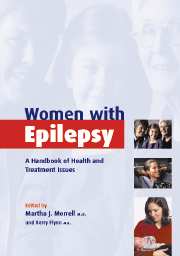Book contents
- Frontmatter
- Contents
- List of contributors
- Part I The woman with epilepsy
- 1 Introduction: why we wrote this book
- 2 On being a woman with epilepsy
- 3 The woman with epilepsy: a historical perspective
- 4 Quality of life issues for women with epilepsy
- Part II Epilepsy diagnosis and treatment
- Part III Hormones and the brain
- Part IV Health challenges for women with epilepsy
- Part V Family planning, pregnancy, and parenting
- Part VI Living well with epilepsy
- Appendix: The Epilepsy Foundation's Campaign for Women's Health: bringing help and hope to women with epilepsy
- Index
- References
3 - The woman with epilepsy: a historical perspective
from Part I - The woman with epilepsy
Published online by Cambridge University Press: 02 November 2009
- Frontmatter
- Contents
- List of contributors
- Part I The woman with epilepsy
- 1 Introduction: why we wrote this book
- 2 On being a woman with epilepsy
- 3 The woman with epilepsy: a historical perspective
- 4 Quality of life issues for women with epilepsy
- Part II Epilepsy diagnosis and treatment
- Part III Hormones and the brain
- Part IV Health challenges for women with epilepsy
- Part V Family planning, pregnancy, and parenting
- Part VI Living well with epilepsy
- Appendix: The Epilepsy Foundation's Campaign for Women's Health: bringing help and hope to women with epilepsy
- Index
- References
Summary
Dr Orrin Devinsky is an eminent epilepsy specialist and former member of the Professional Advisory Board of the Epilepsy Foundation. In this chapter, he reviews the medical history of epilepsy as it relates to women, drawing on his own extensive knowledge about epilepsy, its treatment, and an impressive personal collection of historical texts. Where we are now relates to where we have been. The medical and social histories of epilepsy are filled with stories of wrong information and wrong action. Much of the misunderstanding has impacted women especially. They were thought to suffer from gynecological diseases, unhealthy sexual impulses, and were even considered to be witches. Modern-day therapies have improved the life of the woman with epilepsy. Advances in medical knowledge have put old superstitions and fears to rest. Yet stigma persists. The best way to address this stigma is to understand the source and have access to the information that will end discrimination.
MJMEpilepsy has affected humans since the dawn of the species and has been recognized since the earliest medical writings. Few medical conditions have attracted so much attention and controversy. Throughout history, people with epilepsy, as well as their families, suffered unfairly because of the ignorance of others. Fortunately, the stigma and fear generated by the words seizure and epilepsy have increasingly diminished during the last century, and the majority of those with seizure disorders now lead a normal life.
- Type
- Chapter
- Information
- Women with EpilepsyA Handbook of Health and Treatment Issues, pp. 17 - 34Publisher: Cambridge University PressPrint publication year: 2003
References
- 1
- Cited by

